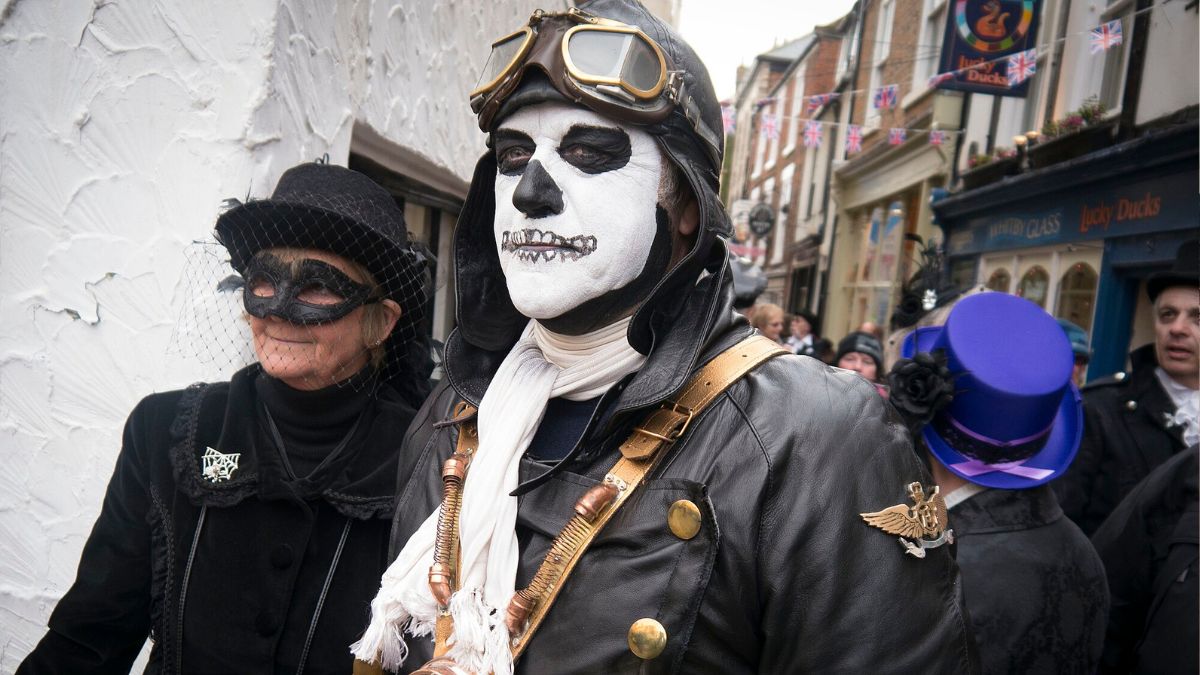Whitby is the host for both Goth and Steampunk weekends. But what's the difference between Goth and Steampunk?
Goth and Steampunk are two popular subcultures. While they may share similarities, such as a love for dark and alternative fashion, music, literature and art, they have distinct differences. In this article, we will explore the key characteristics of both Goth and Steampunk.
What is Steampunk?

Steampunk is a science fiction or fantasy subgenre incorporating technology and aesthetic designs inspired by 19th-century industrial steam-powered machinery.

Whitby Mini Guide
We have created a FREE mini-guide with all the essential information about Whitby, now available for instant download.
Steampunk often features anachronistic inventions and retro-futuristic styles, imagining what the world would look like if modern technology had been developed earlier.
The genre has become popular in literature, fashion, art, and even architecture and often features Victorian-era clothing, steam-powered machines, and a blend of historical and fictional elements.
What is Goth?

Goth is a subculture that emerged in the United Kingdom during the late 1970s. It is characterised by its dark, eerie and melancholic aesthetics.
Fashion, music and art are all part of this subculture. Gothic music is often associated with post-punk, darkwave, and alternative rock and is known for its moody and atmospheric sound. Gothic fashion is often characterised by black clothing, leather, lace, and stockings. Dark themes, such as death, decay, and the supernatural, often characterise Gothic art.
The Origins of Goth and Steampunk
The origin story of Steampunk can be traced back to literature, particularly the romantic Victorian fantasies influenced by famous literary works such as those of Mary Shelley, Jules Verne, H.G. Wells, and Edward S. Ellis. Interestingly, “Steampunk” was coined in the late 1980s as a playful response to cyberpunk.
The roots of Goth can be traced back to the early 1980s post-punk music scene, which eventually evolved into Goth Rock. Influential bands like Siouxsie and the Banshees, Joy Division, Bauhaus, and The Cure significantly shaped the Goth subculture we know today.
It is worth noting that the term “Goth” is often confused with “Gothic,” which is an aesthetic associated with artists like Marilyn Manson, filmmakers like Tim Burton, or painters like H.R. Giger. However, these examples are not necessarily representative of Goth subculture music. Instead, Goth is about the music, while Gothic relates to aesthetics.
What is the difference between Goth and Steampunk fashion?

While both Goth and Steampunk fashion have a Victorian-inspired aesthetic, there are differences between the two.
Goth fashion tends to be darker and more macabre, emphasising black clothing, leather, lace, and heavy makeup. On the other hand, Steampunk fashion incorporates elements of Victorian fashion with industrial and mechanical motifs, such as gears, cogs, and brass accents. Steampunk outfits often feature vintage and modern elements, including corsets, waistcoats, top hats, goggles, and pocket watches.

Steampunk fashion draws inspiration from British fashion's romantic industrial Victorian era, while the Gothic subculture encompasses a wide range of fashion styles. Some of the different types of Gothic fashion include Romantic Goth, Victorian Goth (which are closest in style to Steampunk), Lolita Goth, Trad Goth, Cybergoth, Pastel Goth, Gothabilly, Fetish Goth, and many more.
What is the difference between Goth Weekend and Steampunk Weekend in Whitby?

Whitby hosts both Goth and Steampunk weekends. Goth weekend is typically held twice a year and is centred around the subculture of Gothic fashion, music, and art. It celebrates all things dark, macabre, and mysterious, with attendees sporting black clothing, leather, lace, and heavy makeup.
Around forty pen pals met at the Elsinore Pub in Whitby, which led to the start of the original event. Even today, The Little Angel remains a central meeting point during the Whitby Goth Weekend. The festival has gained immense popularity over the years. It is now recognised as the world's premier goth festival, bringing thousands of visitors to the town in spring and autumn.
Famous bands such as The Damned and artists including Toyah have graced the festival’s stages over the years. Fields of Nephilim and The Sisters of Mercy have become more recent favourites. Learn more about Whitby Goth Weekend here.

In contrast, Steampunk Weekend celebrates all things Victorian and industrial, with attendees often wearing costumes featuring gears, cogs, and brass accents.
The event incorporates elements of science fiction and fantasy and historical reenactment. Steampunk Weekend usually includes workshops, exhibitions, and performances related to science, technology, and art.
The event's first edition was held in 2017 and has since grown in popularity. Its family-friendly atmosphere and free entry during the day make it an excellent opportunity to visit this seaside town. Learn more about Whitby Steampunk Weekend here.
What is the difference between Gothic and Steampunk literature?
The Gothic literary movement has existed for centuries, preceding the modern Gothic subculture we see today. However, it has played a significant role in shaping the subculture's aesthetic.
While the influence of Gothic literature on the early goth scene was mainly indirect, modern genres like horror or paranormal fantasy that evolved from the original Gothic movement continue to be popular among goths.

Although traditional Gothic literature is less well-known today, its core themes and features continue to influence modern genres, including steampunk literature.
Unlike Gothic literature, Steampunk literature directly influenced the development of the Steampunk subculture. The term “Steampunk” was coined in the late 1980s to describe contemporary novels written in a style that emulated Victorian-era speculative fiction writers such as H. G. Wells and Jules Verne. Since then, the Steampunk scene has evolved alongside its literature, with its own social, music, and fashion scenes.
Whitby's connections to Dracula

It's safe to assume that most fans of the story or visitors to Whitby know the town's connection to Dracula. Nevertheless, it is an exciting tale that further cements Whitby's association with all things Gothic. Bram Stoker was residing in Whitby when he created his most famous work.
During his stay in Whitby, Bram Stoker was already working on a story set in Austria. With Count Wampyr as the central character. This was probably because the literature then was inclined towards tales of foreign lands, eerie castles, and everything Gothic.

Unsurprisingly, the streets and lanes of Whitby have a similar vibe, which Stoker found especially true of Whitby Abbey and the Church of St Mary below it.
Bram Stoker’s love for Whitby and the surrounding area is evident when you read the words of his novel’s characters, such as Mina. One of the book’s main characters, Mina, keeps a journal describing many scenic areas in and around the town when Stoker was there.
If you're ever in Whitby, the Dracula Experience is worth a visit!
Click here to find out why Goths love Whitby.
Both Steampunk Weekend and Goth Weekend in Whitby are fantastic celebrations. You may be interested in the impressive DIY mechanical creations and the Victorian literature of Steampunk Weekend. Or more into the melancholic music of the Goth subculture.
Don't limit yourself to just one – you can enjoy both events! We always find one thing in common whenever we have attended either event. That's how friendly and welcoming everyone is.
Header image credit: Bryan Ledgard, CC BY 2.0, via Wikimedia Commons.









Related Posts